Abstract
CONTEXT:
Scientific research not only promotes health and combats diseases of an individual, but also it can strengthen the effectiveness of health systems. Hence, understanding of scientific methods becomes a crucial component in the medical profession.
AIMS:
This study was conducted to assess the knowledge, attitudes, and barriers toward research among undergraduate medical and dental students.
SETTINGS AND DESIGN:
This cross-sectional study was conducted among 295 undergraduate Bachelor of Medicine and Bachelor of Surgery (MBBS) and Bachelor of Dental Surgery (BDS) students from a private medical college in Malaysia.
MATERIALS AND METHODS:
We purposively selected 360 students attending the 3rd, 4th, and 5th year in MBBS course and BDS course in September 2015. A total of 295 students who were willing to provide written informed consent were included in this study. We collected data using a validated, self-administered, structured questionnaire which included 20 questions about knowledge toward scientific research, 21 attitude items in regard to scientific research, a list of 10 barriers toward conducting medical research, and 5 questions of confidence to conduct the medical research.
STATISTICAL ANALYSIS USED:
Data were analyzed using descriptive statistics, independent t-test, ANOVA, and multiple linear regression.
RESULTS:
Among the students, 56.9% had moderate knowledge while the majority (83.3%) had moderate attitude toward scientific research. The majorly cited barriers were the lack of time (79.9%), lack of knowledge and skills (72.1%), lack of funding (72.0%) and facilities (63.6%), and lack of rewards (55.8%). There was a significant association between age, academic year, and knowledge of research as the older age group, and 4th- and 5th-year students had higher knowledge score. The students of higher attitude score had better-perceived barriers score toward research with regression coefficient 0.095 (95% confidence interval 0.032–0.159).
CONCLUSIONS:
Even though the students had the positive attitudes toward scientific research, a supportive and positive environment is needed to improve skills and knowledge of research and to overcome the barriers toward the conduct of scientific research.
Keywords: Attitudes, barriers, knowledge, research, undergraduate students
Introduction
Research is important to the scientific progress,[1] and it is also crucial to the understanding of problems which affects the health of individuals, communities, and health systems.[2] Research involves systematic investigation or experimentation to discover the new knowledge[2] and revision of current knowledge.[3] In 2007, developed countries had 3655.8 researchers per million inhabitants when only 580.3 researchers in the developing world.[4] A total number of scientific publications were 315,742 in the developing countries when it was doubled in developed. In Malaysia, the gross domestic expenditure on research and development per GDP ratio had increased from 0.49% in 2000 to 0.64% in 2006.[4] As a result, publications output has risen rapidly in the past decade from 805 scientific publications in the year 2000 to 2712 publications in the year 2008, in which 300 publications of medical research and 535 publications of clinical medicine.[4]
Research is vital to developmental activities and it had been carried out in all academic and developmental institutions.[5] In medical education, health research training is an essential component to help developing physician's research skills,[6] including literature search, critical appraisal, independent learning, and writing research papers.[7] Training for research skills and experience of research in an early time in the medical profession is associated with continued professional academic work and may also help resident's career decisions.[7] While many undergraduate programs include research methodology course,[8] medical training in many developing countries does not emphasize its importance in medical practice and this course is not included in the medical curriculum.[7] Compulsory research course along with a mandatory research project has a positive impact on student's knowledge and attitudes toward research.[9,10] Moreover, it provides necessary skills to the future research in their career[3] and strengthens lifelong learning.[11] Moreover, research by a student can significantly affect the published output of the institution, and to a further extent, also of the country.[7,12]
Several studies have been carried out in many countries to evaluate knowledge and attitudes toward scientific research among health professionals and medical students.[9,10,13,14,15,16] Evidence also showed that existence of barriers brings the gap between theory of scientific research and practice of conducting it.[17] Furthermore, lack of skills training, infrastructure and facilities, mentorship, and lack of time and motivation were cited as the major hurdles.[6,9,13,14,18,19] In Malaysia, knowledge, attitudes, and barriers toward conduct of medical research and evidence-based medicine were investigated among health professionals such as doctors, specialists, pharmacists, nurses, and physiotherapists;[20,21,22,23,24] however, there is limited information on this topic among undergraduate medical and dental students.
Research is mandatory and it is one part of the core curriculum in the Bachelor of Medicine and Bachelor of Surgery (MBBS) and Bachelor of Dental Surgery (BDS) course in our private medical college. The aim of the course is to introduce principles of scientific research and biostatistics using various problem-solving exercises and to provide the skills that can effectively contribute in various institutional research projects. In the final year, students require performing research projects which is mentored by the faculty members. While conducting research projects, students learn to identify the research question, generate research hypotheses, critically appraise literature, design the study, collect and analyze the data, and write a detailed project report. Although it is not compulsory, students are also encouraged to publish their researches in medical journals and do presentations in conferences. This study aims to assess the knowledge and attitudes toward scientific research and to identify the barriers to participation in scientific research among undergraduate medical and dental students, expect promoting research skills and increasing published outputs of the college.
Materials and Methods
We conducted a cross-sectional study among undergraduate medical and dental students in September 2015 in the private medical college in Malaysia. Approximately 800 students were attending in the MBBS and BDS program. The sample size was calculated using the formula for single population proportion with the margin of error 5%, the assumption of 95% confidence level,[25] and 80.2% of moderate knowledge.[6] The minimum sample size required was 245; however, we purposively selected 360 students attending the 3rd, 4th and 5th year in MBBS course and BDS course. The students who were willing to provide written informed consent were included in this study.
We collected data using a self-administered, structured questionnaire within a span of 4 months. The questionnaire was adapted from the previous studies.[9,14,26] The questionnaire consisted of sociodemographic, previous experience of scientific research, knowledge and attitudes toward research, and perceived barrier conducting research. In this study, 20 questions including single best answer type of multiple-choice questions and true/false questions were used for assessing knowledge. Five-point Likert scale (strongly agree, agree, neutral, disagree, and strongly disagree) was used to assess the attitudes toward research. Attitudes part consisted of 21 items including 11 positive and 10 negative statements. Ten items of perceived barriers with three-point Likert scale (agree, disagree, and undecided) were also included. After modification of the questionnaire, we carried out a pilot study with 30 students to check for validity, reliability, clarity, and understanding of the questionnaire. Content validity was checked with experts and face validity was checked for clarity and understanding of the questionnaire. The Cronbach's alpha coefficient of knowledge questions was 0.648, of attitude questions was 0.824, and of barriers questions was 0.683.
After checking and coding the questionnaire, we used Microsoft Excel for data entry and SPSS version 12 (SPSS Inc, Chicago, IL) for data analysis. Regarding knowledge, the correct answer was scored one and wrong/not sure answer was scored zero (higher score indicates better knowledge). For attitudes, for positive items, strongly agree was scored five and strongly disagree was scored one, while for negative items, strongly agree was scored one and strongly disagree was scored five (higher score indicates better attitude). Regarding perceived barrier, disagree was scored three, score one for agree, and score two for undecided (higher score indicates lesser perceived barrier). The total score was computed by taking the sum for all of these. We categorized knowledge and attitudes into three levels such as good (>80% of the maximum possible total score), moderate (60%–80% of the maximum possible total score), and poor (<60% of the maximum possible total score).
For quantitative variables, mean and standard deviation (SD) were calculated and for qualitative variables, frequency and percentage were described. We used independent sample t-test and one-way ANOVA to determine the knowledge, attitudes, and perceived barriers toward research between different age groups, gender, ethnicity, and academic years. We also performed multiple linear regression to find the relationship between knowledge, attitudes, and perceived barriers after adjusting other covariates. All the statistical tests were two-sided and the level of significance was set at 0.05.
Before data collection, the purpose of the study was explained to the respondents. Participation was strictly voluntary and autonomy of the respondents was respected. Written informed consent was taken from each participant. Confidentiality was maintained and anonymity of respondents was ensured. In addition, data were kept secured and available only to the statistician. Approval for this study was taken from Research Committee of our college.
Results
A total of 295 students participated in this study and response rate was 81.94%. Among them, 62.4% were from MBBS program and 37.6% were BDS students while 59.3% of the participants were from 3rd year, 33.9% from 4th year, and 6.8% from 5th year. The mean age of the participants was 22.99 years (SD 1.05) and the majority (97.3%) of them was Malaysian nationality. 59.5% of them were female students [Table 1].
Table 1.
Demographic characteristics among medical and dental students (n=295)
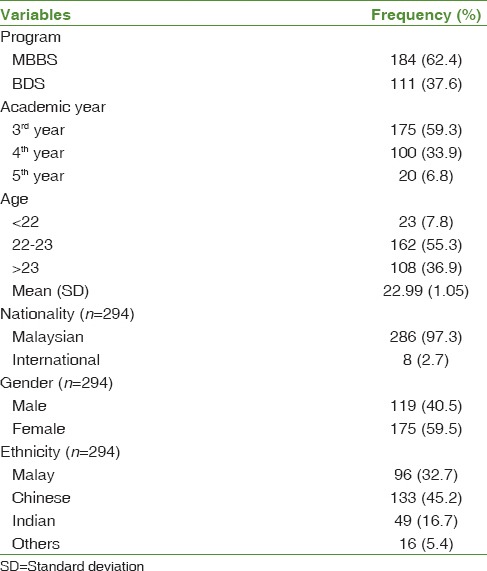
In this study, only 4% of the students had good knowledge while 56.9% had moderate knowledge. The majority (83.3%) had moderate attitude and 11.3% of the students had good attitude. The mean of perceived barriers was 17.84 out of 30 (higher score indicates lesser perceived barrier). Nearly 13.4% of the students had performed presentations in conference and 5.8% published research articles [Table 2]. Percentage of answers on attitude questions among undergraduates is shown in Table 3.
Table 2.
Knowledge, attitudes, perceived barriers toward research and previous research experience among medical and dental students
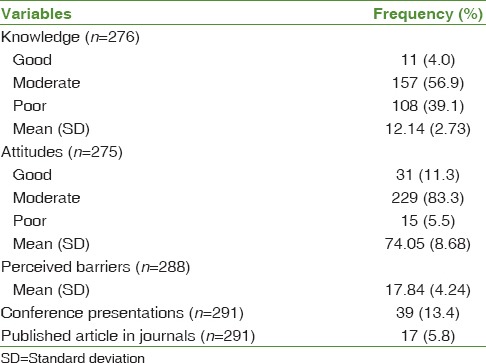
Table 3.
Percentage of answers on attitude questions among medical and dental students
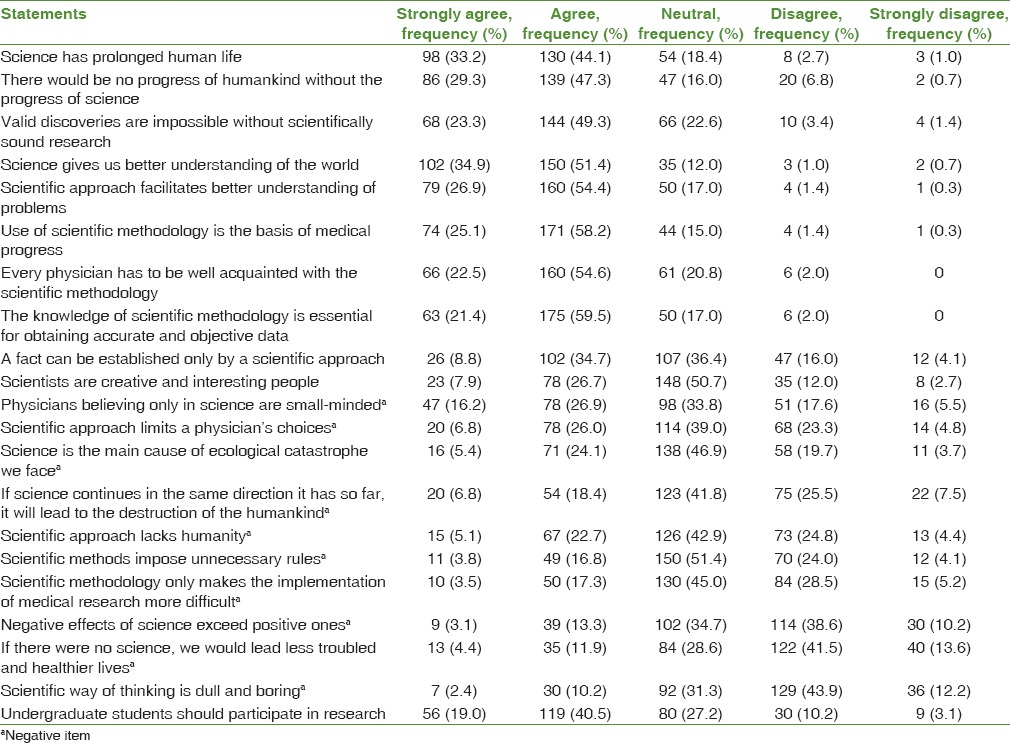
In regard to barriers, majority of the students had stated lack of time (79.9%), lack of knowledge/skills (72.1%), and lack of funding (72%). Other barriers revealed lack of facilities (63.6%), lack of rewards (55.8%), inaccessible to relevant medical and other electronic databases (44.0%), lack of interest (37.5%), inefficient faculty staff to deliver necessary knowledge and skills (26.6%), lack of proper mentoring (20.5%), and opportunity to conduct (20.2%) [Table 4].
Table 4.
Perceived barriers to participation in research among medical and dental students
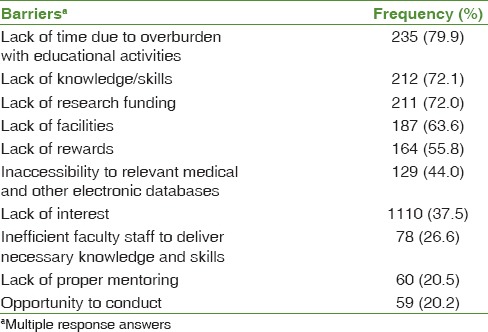
Most of the students had limited or somewhat confidence in creating a clinical question (37.6% limited and 47.4% somewhat), search for literature (34.8% limited and 45.5% somewhat), critical appraisal (38.1% limited and 44.3% somewhat), access clinical expertise from instructor (41% limited and 40.7% somewhat), and using evidence-based processes (38.3% limited and 40.3% somewhat) [Table 5].
Table 5.
Confidence of doing research activities among undergraduate students

Table 6 shows that there was a significant association between age, academic year, and knowledge. Age >23 years had higher mean knowledge score than age 22–23 years and <20 years. As regards the academic year, 4th-year and 5th-year students had higher knowledge score than 3rd-year students. There was also a significant relationship between ethnicity and attitudes toward research as Indian had higher attitude score than Chinese and Malay. Moreover, age was significantly associated with perceived barriers and age >23 years had the highest mean barriers score among all age groups. There were no significant relationship between gender, ethnicity, and knowledge; no significant association between age, gender, academic year, and attitudes; and no significant relationship between gender, ethnicity, academic year, and perceived barriers toward research [Table 6].
Table 6.
The relationship between demographic characteristics and knowledge, attitudes, and perceived barriers toward research
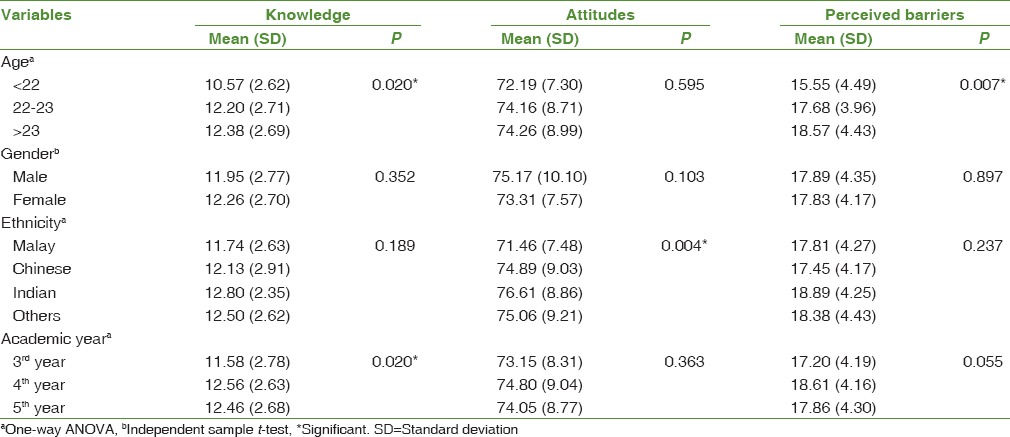
We performed multiple linear regression to determine the relationship between knowledge, attitudes, and perceived barriers toward research after adjusting the other covariates such as age, gender, ethnicity, and the academic year. We assessed model fit and found that there were linearity, independence of residuals, homoscedasticity, and no evidence of multicollinearity, and the assumption of normality was met. The multiple linear regression model was statistically significant with F (10,240) = 3.337, P 0.001, and adjusted R2 = 0.078. There was no significant relationship between knowledge and barriers toward research. However, there was a significant positive relationship between attitudes and barriers with regression coefficient of 0.095 (95% confidence interval 0.032–0.159), P = 0.003 [Table 7].
Table 7.
Multiple linear regression analysis of relationship between knowledge, attitudes, and perceived barriers toward research

Discussion
We conducted the cross-sectional study to assess the knowledge, attitudes, and the barriers toward the conduct of scientific research among undergraduate medical and dental students in our private medical college. Understanding of scientific methods becomes a crucial component of the medical profession. Although every health professional is not inspired to perform research to acquire new knowledge, he or she should be able to know principles of scientific research.[3,14] In this study, we found that 56.9% of the students had moderate and 39.1% had poor level of knowledge, with a mean score 12.14 of maximum 20. Previous studies done among undergraduate students showed poor-to-moderate level of knowledge toward health research.[9,10,14,19] Similarly, the study done among postgraduate trainees revealed poor level of knowledge toward research as 80.2% of them was in the first two quartiles of knowledge score.[6] Moreover, attitude toward health research is one of the important predictors of evidence-based practice and health care research utilization.[27,28,29,30] Systematic review of attitudes to science in medicine revealed that 49.5% of the students had positive attitudes,[31] and observational studies done among health professionals and medical students also demonstrated moderate and positive attitudes toward research.[6,10,14,19,27] In this study, the response rate was 81.94% which reflects the positive attitudes of students toward scientific research as 83.3% of the students had moderate attitude and 11.3% had good attitude. The students also demonstrated positive attitudes toward science and scientific methodology in medicine. Similar to other studies,[6,9,10] many of our participants showed somewhat to extensive confidence in conducting research activities such as creating clinical questions and searching and appraising literature, but many of them expressed limited confidence in accessing clinical expertise from the instructor and utilizing evidence-based processes. If the health professionals had perceived ability to perform research activities, they are more likely to involve in medical research.[27] In our college, research methodology course is compulsory in the medical curriculum and it is given in the 3rd year in MBBS and 4th year in BDS program. A previous study done by Bonner and Sando had also shown that if the health professionals had not taken research training or course, they felt lack of skills to perform research.[13]
The relationship between individual characteristics such as age, gender, year of education, and knowledge of and attitudes toward health research had been studied.[9,10,13,14,15] It was shown that knowledge was negatively correlated with age of the students,[9] and the number of years spent in medical college was significantly associated with knowledge of research after adjusting for age.[10] In our study, the mean score of both knowledge and attitude was highest in oldest age group and we found that age was significantly related to knowledge but not with attitudes. The academic year of the student was also significantly associated only with knowledge toward research. Apart from compulsory research methodology course, final-year students are also needed to perform the research projects, which are mentored by the faculty members. While conducting these projects, students learn to identify a research question, generate research hypotheses, critically appraise literature, design the study, collect and analyze the data, and write a detailed project report. Similar to the study conducted among the licensed nurses by Bonner and Sando,[13] we found that senior year students had a better understanding, higher mean score of knowledge, and a positive attitude. Intensive training of research principles and mandatory participation in research activities can lead to the significant improvement in content knowledge and positive impact on attitudes toward future research.[9,10,15] Though the results of the relationship between gender and knowledge were not consistent with previous studies,[9,10,16] in this study, we found that female students had higher knowledge score and males had higher attitude score, but it was not significant. There was no significant association between ethnicity and knowledge, but it was significantly associated with attitudes toward research. The mean score of both knowledge and attitude scale was highest in Indian followed by others, Chinese and Malay. Our findings were different from the previous study done among Malaysians showed Malay had the highest level of interest in science-, technology-, and innovation-related issues and more positive attitudes toward scientific research than Chinese and Indian.[32]
Although the emphasis is given to promote scientific research, the presence of barriers bring the gap between theory and practice.[17] The barriers to participate in scientific research can be classified as extrinsic[33] such as lack of training in research methodology, lack of time due to overburdened with educational activities, lack of rewards and incentives, lack of infrastructure and facilities, inadequate support by organization/institute, access to library and publications, and inadequate supervision and mentorship,[5,6,9,13,14,17,18,19,20] and intrinsic[33] including lack of motivation and lack of appropriate knowledge and skills in scientific methods and statistics.[9,17,14,19,20,21] In this study, the most common obstacles stated by the students were lack of time, lack of knowledge/skills, lack of funding and facilities, and lack of rewards. Moreover, the students mentioned limited access to the relevant medical and other electronic databases made them difficult to discover knowledge gap and initiate their research activities. We also found that the students who had higher attitude score had better-perceived barriers score toward research. Previous studies showed that attitudes toward research involvement and utilization are essential in evidence-based medicine[27] and adoption of negative attitudes could make difficulty in implementation of scientific research.[17] It has been accepted that supportive positive environment can bring successful researcher and have an impact on research output including publications.[3] We found that 13.4% of the students had ever done oral and poster presentations and some of them received awards in national student conferences. However, only 5.8% of the students had ever published research papers in indexed journals which were lower than previous studies.[6,7,31]
There are some limitations in this study. The response rate of the final year students was lowest (6.8%) because they were given study break at the time of data collection. This study was conducted in one private medical institution; therefore, the findings cannot be applicable to other institutions with the different environment. This was a cross-sectional study; therefore, we could neither observe the changes over time nor inference of causality. In this study, we did not include other barriers such as organizational, strategic, and policy barriers, communication barriers, and cultural and language barriers; therefore, further study should explore on these aspects. A qualitative approach will also offer a better understanding of obstacles toward research participation of undergraduate students. As the faculty members are the most important resources, the perception of faculty members toward scientific research and toward student's research should also be studied.
Conclusions
The undergraduate medical and dental students had the moderate level of knowledge and positive attitudes toward the conduct of medical research. Lack of time, skills, funding, and facilities and limited access to relevant medical journals and databases were the major barriers. These barriers need to be addressed by providing proper supervision, good mentorship, research funding and awards, and providing access to electronic databases to encourage the undergraduate students participating in research activities. It is recommended to organize research workshops, frequent research presentations, and journal clubs to provide knowledge and skills needed for the medical students to implement the scientific research in the future.
Financial support and sponsorship
Nil.
Conflicts of interest
There are no conflicts of interest.
Acknowledgment
We would like to acknowledge to all students who participated in this study and the volunteer students who helped for data collection. We would like to thank Professor Dr. Soe Moe for her valuable suggestion in concept and design of this study. We also would like to thank the management of Melaka-Manipal Medical College (MMMC) and Research Ethics Committee (MMMC) to grant the approval of this study.
References
- 1.Marczyk GR, Dematteo D, Festinger D. Essentials of Research Design and Methodology. New Jersey: John Wiley & Sons; 2005. [Google Scholar]
- 2.Amar-Singh HS, Bakar AA, Sararaks S. The Medical Research Handbook: Planning a Research Project. 1st ed. Perak: Clinical Research Centre Perak (CRC Perak) and the Institute for Health Systems Research (IHSR); 2008. [Google Scholar]
- 3.Hickson M. Research Handbook for Health Care Professionals. 1st ed. Oxford: Wiley-Blackwell; 2008. [Google Scholar]
- 4.Paris: United Nations Educational, Scientific and Cultural Organization; 2010. United Nations Educational, Scientific and Cultural Organization (UNESCO). UNESCO Science Report 2010: The Current Status of Science around the World. [Google Scholar]
- 5.Goyal RC. Research Methodology for Health Professionals. 1st ed. New Delhi: Jaypee Brothers Medical Publishers; 2013. [Google Scholar]
- 6.Khan H, Khan S, Iqbal A. Knowledge, attitudes and practices around health research: The perspective of physicians-in-training in Pakistan. BMC Med Educ. 2009;9:46. doi: 10.1186/1472-6920-9-46. doi: 10.1186/1472-6920-9-46. https://www.ncbi.nlm.nih.gov/pmc/articles/PMC2719622 . [DOI] [PMC free article] [PubMed] [Google Scholar]
- 7.Aslam F, Shakir M, Qayyum MA. Why medical students are crucial to the future of research in South Asia?? PLoS Med. 2005;2:e322. doi: 10.1371/journal.pmed.0020322. doi: 10.1371/journal.pmed.0020322. http://journals.plos.org/plosmedicine/article?id=10.1371/journal.pmed.0020322. [DOI] [PMC free article] [PubMed] [Google Scholar]
- 8.Rash EM. A service learning research methods course. J Nurs Educ. 2005;44:477–478. doi: 10.3928/01484834-20051001-07. [DOI] [PubMed] [Google Scholar]
- 9.Amin TT, Kaliyadan F, Qattan EA, Majed MH, Khanjaf HA, Mirza M. Knowledge, attitudes and barriers related to participation of medical students in research in three Arab Universities. Educ Med J. 2012;4:e43–e56. [Google Scholar]
- 10.Khan H, Khawaja MR, Waheed A, Rauf MA, Fatmi Z. Knowledge and attitudes about health research amongst a group of Pakistani medical students. BMC Med Educ. 2006;6:54. doi: 10.1186/1472-6920-6-54. https://bmcmededuc.biomedcentral.com/articles/10.1186/1472-6920-6-54 . [DOI] [PMC free article] [PubMed] [Google Scholar]
- 11.Azizan SA. Strenghtening Malaysia's scientific and technological development through human capital development. Procedia Soc Behav Sci. 2013;91:648–653. [Google Scholar]
- 12.Cursiefen C, Altunbas A. Contribution of medical student research to the medline ™-indexed publications of a German medical faculty. Med Educ. 1998;32:439–440. doi: 10.1046/j.1365-2923.1998.00255.x. [DOI] [PubMed] [Google Scholar]
- 13.Bonner A, Sando J. Examining the knowledge, attitude and use of research by nurses. J Nurs Manag. 2008;16:334–343. doi: 10.1111/j.1365-2834.2007.00808.x. [DOI] [PubMed] [Google Scholar]
- 14.Vodopivec I, Vujaklija A, Hrabak M, Lukić IK, Marusić A, Marusić M, et al. Knowledge about and attitude towards science of first year medical students. Croat Med J. 2002;43:58–62. [PubMed] [Google Scholar]
- 15.Campisi J, Finn KE. Does active learning improve student's knowledge of and attitudes toward research methods? J Coll Sci Teach. 2011;40:38–45. [Google Scholar]
- 16.Burgoyne LN, O’Flynn S, Boylan GB. Undergraduate medical research: The student perspective? Med Educ Online. 2010;15:5212. doi: 10.3402/meo.v15i0.5212. doi: 10.3402/meo.v15i0.5212. https://www.ncbi.nlm.nih.gov/pubmed/20844608 . [DOI] [PMC free article] [PubMed] [Google Scholar]
- 17.Athanasakis E. Nurses’ research behaviour and barriers to research utilization into clinical nursing practice: A close look. Int J Caring Sci. 2013;6:16–28. [Google Scholar]
- 18.Park SJ, Liang MM, Sherwin TT, McGhee CN. Completing an intercalated research degree during medical undergraduate training: Barriers, benefits and postgraduate career profiles. N Z Med J. 2010;123:24–33. [PubMed] [Google Scholar]
- 19.Al-Shalawy FA, Haleem FA. A knowledge attitudes and perceived barriers towards scientific research among undergraduate health sciences students in the central province of Saudi Arabia. Educ Med J. 2015;7:e16–e21. [Google Scholar]
- 20.Teh LC, Prema M, Choy MP, Letchuman GR. Attitudes, barriers and facilitators to the conduct of research in government hospitals: A cross-sectional study among specialists in government hospitals, Northern states of Malaysia. Med J Malaysia. 2017;72:26–31. [PubMed] [Google Scholar]
- 21.Yahui HC, Swaninathan N. Knowledge, attitudes, and barriers towards evidence-based practice among physiotherapists in Malaysia. Hong Kong Physiother J. 2017;37:10–18. doi: 10.1016/j.hkpj.2016.12.002. [DOI] [PMC free article] [PubMed] [Google Scholar]
- 22.Rashid KA, Gomathy S, Manan A. The involvement of doctors in research activities in two major hospitals in Penang Malaysia. Malays J Public Health. 2012;12:31–38. [Google Scholar]
- 23.Birks M, Karen F, Chapman Y, Mills J, Porter J. Supporting the evolution of a research culture among nurses in Malaysia. Aust J Adv Nurs. 2009;27:89–93. [Google Scholar]
- 24.Tan SY, Hatah E. Knowledge, attitudes, practices, and barriers related to research utilization: A survey among pharmacists in Malaysia. Int J Clin Pharm. 2017;39:450–458. doi: 10.1007/s11096-017-0425-7. [DOI] [PubMed] [Google Scholar]
- 25.Lwanga SK, Lemeshow S. Geneva: World Health Organization; 1991. Sample Size Determination in Health Studies: A Practical Manual. [Google Scholar]
- 26.Manspeaker SA, Van Lunen BL, Turocy PS, Pribesh S, Hankemeier D. Student knowledge, attitudes, and use of evidence-based concepts following an educational intervention. Athl Train Educ J. 2011;6:88–98. [Google Scholar]
- 27.Brown T, Tseng MH, Casey J, McDonald R, Lyons C. Predictors of research utilization among pediatric occupational therapists. OTJR Occup Particip Health. 2010;30:172–183. [Google Scholar]
- 28.McCleary L, Brown GT. Association between nurses’ education about research and their research use. Nurse Educ Today. 2003;23:556–565. doi: 10.1016/s0260-6917(03)00084-4. [DOI] [PubMed] [Google Scholar]
- 29.Estabrooks CA. Modelling the individual determinants of research utilization. West J Nurs Res. 1999;21:758–772. doi: 10.1177/01939459922044171. [DOI] [PubMed] [Google Scholar]
- 30.Birdsell J, Thornley R, Landry R, Estabrooks C, Mayan M. The Utilization of Health Research Results in Alberta. Alberta: Alberta Heritage Foundation for Medical Research; 2005. [Google Scholar]
- 31.Naing C, Wai VN, Durham J, Whittaker MA, Win NN, Aung K, et al. A systematic review and meta-analysis of medical students’ perspectives on the engagement in research. Medicine (Baltimore) 2015;94:e1089. doi: 10.1097/MD.0000000000001089. doi: 10.1097/MD.0000000000001089. https://www.ncbi.nlm.nih.gov/pmc/articles/PMC4617066 . [DOI] [PMC free article] [PubMed] [Google Scholar]
- 32.Ministry of Science, Technology and Innovation (MOSTI). Public Awareness of Science, Technology and Innovation, Malaysia 2014. Putrajaya: Malaysia Science and Technology Information Centre (MASTIC), Ministry of Science, Technology and Innovation (MOSTI) 2014 [Google Scholar]
- 33.Ertmer P. Addressing first-and second-order barriers to change: Strategies for technology integration. Educ Technol Res Dev. 1999;47:47–61. [Google Scholar]


